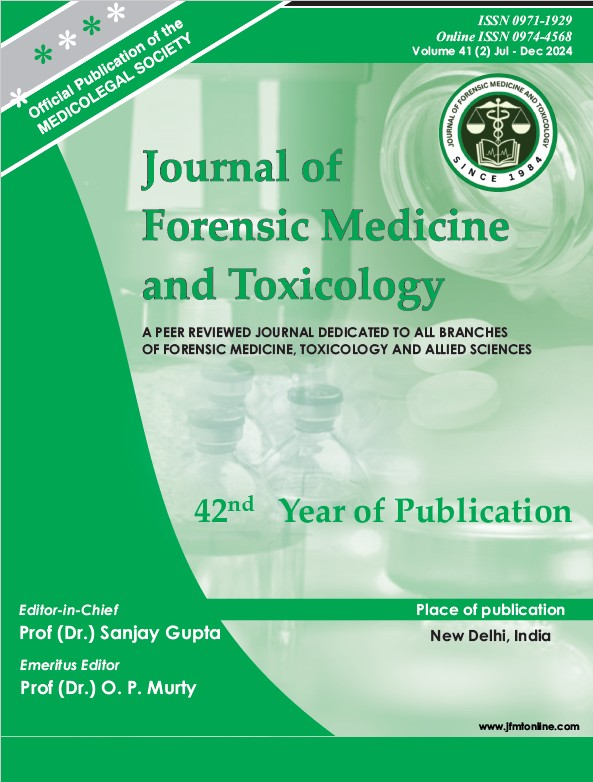Ingesting the future: Navigating the perils of Nano-liquid urea A case study & Review of Literature
DOI:
https://doi.org/10.48165/jfmt.2025.42.2.22Keywords:
Nano-liquid urea, suicide attempt, human vulnerability, uremic toxicity, mental healthAbstract
This case study aims to present the first documented suicide attempt involving the ingestion of nano-liquid urea, a nano technology-based fertilizer recently introduced in Indian agriculture. This study examines the clinical aspects including signs, symptoms, laboratory investigations, and treatment, while simultaneously exploring the underlying psychosocial aspects. By doing so, our goal is to illuminate the intersection between technological advancement, human vulnerability, and the responsibilities that come with scientific innovation.
Downloads
References
Kumar, Y. O., Tiwari, K. N., Singh, T., & Raliya, R. (2021). Nanofertilizers and their role in sustainable agriculture. Annals of Plant and Soil Research, 23(3), 238–255.
Sekhon, B. S. (2014). Nanotechnology in agri-food production: An overview. Nanotechnology, Science and Applications, 2014, 31–53.
Naderi, M. R., & Abedi, A. (2012). Application of nanotechnology in agriculture and refinement of environmental pollutants. Journal of Nanotechnology, 11(1), 18–26.
DeRosa, M. C., Monreal, C., Schnitzer, M., Walsh, R., & Sultan, Y. (2010). Nanotechnology in fertilizers. Nature Nanotechnology, 5(2), 91–94.
Trenkel, M. E. (2021, May 20). Slow-and controlled-release and stabilized fertilizers: An option for enhancing nutrient use efficiency in agriculture. International Fertilizer Industry Association (IFA).
Solanki, P., Bhargava, A., Chhipa, H., Jain, N., & Panwar, J. (2015). Nano-fertilizers and their smart delivery system. In Nanotechnologies in food and agriculture (pp. 81–101).
Rahale, C. S. (2010). Nutrient release pattern of nano–fertilizer formulations (Ph.D. thesis).
Tomar, M., Choudhary, R., & Patidar, R. (2023). Chapter 1: Nano urea—A bliss for agriculture or not. In Recent Trends in Agriculture (p. 1).
World Health Organization. (2014). Preventing suicide: A global imperative. Geneva: WHO.
De Moore, G. M., & Robertson, A. R. (1996). Suicide in the 18 years after deliberate self-harm: A prospective study. The British Journal of Psychiatry, 169(4), 489–494.
World Health Organization. (n.d.). Suicide. Retrieved from https://www.who.int/news-room/fact-sheets/detail/suicide
National Crime Records Bureau. (2022). Chapter 2: Suicides in India. Retrieved from https://ncrb.gov.in/sites/default/files/ADSI-2021/adsi2021_Chapter-2-Suicides.pdf
Soper, C. A. (2019). The evolution of suicide. Cham, Switzerland: Springer Nature.
Steyn, D. G. (1961). An outbreak of urea poisoning among Bantu farm laborers in the Potgietersrust district, Transvaal. South African Medical Journal, 35(35), 721–722.
Vagdatli, E., Gounari, E., Lazaridou, E., et al. (2010). Platelet distribution width: A simple, practical and specific marker of activation of coagulation. Hippokratia, 14, 28–32.
Tzur, I., Barchel, D., Izhakian, S., et al. (2019). Platelet distribution width: A novel prognostic marker in an internal medicine ward. Journal of Community Hospital Internal Medicine Perspectives, 9(6), 464–470.
Eknoyan, G., Wacksman, S. J., Glueck, H. I., & Will, J. J. (1969). Platelet function in renal failure. New England Journal of Medicine, 280(13), 677–681.
El Far, M. M., El Naggar, O. M., Elkhawaga, Y. O. A., et al. (2006). Carcinoembryonic antigen, alpha-fetoprotein, and prostate-specific antigen in the sera of industrial workers exposed to phenol, formaldehyde, urea, and mixed vapors. Inhalation Toxicology, 18(13), 1041–1046
Lau, W. L., & Vaziri, N. D. (2017). Urea, a true uremic toxin: The empire strikes back. Clinical Science, 131(1), 3–12.
D’Apolito, M., Du, X., Zong, H., et al. (2010). Urea-induced ROS generation causes insulin resistance in mice with chronic renal failure. Journal of Clinical Investigation, 120(1), 203–213.
Trécherel, E., Godin, C., Louandre, C., et al. (2012). Upregulation of BAD, a pro-apoptotic protein of the BCL2 family, in vascular smooth muscle cells exposed to uremic conditions. Biochemical and Biophysical Research Communications, 417(1), 479–483.
Vaziri, N. D., Yuan, J., & Norris, K. (2013). Role of urea in intestinal barrier dysfunction and disruption of epithelial tight junction in chronic kidney disease. American Journal of Nephrology, 37(1), 1–6.
D’Apolito, M., Du, X., Pisanelli, D., et al. (2015). Urea-induced ROS cause endothelial dysfunction in chronic renal failure. Atherosclerosis, 239(2), 393–400.
Koppe, L., Nyam, E., Vivot, K., et al. (2016). Urea impairs β cell glycolysis and insulin secretion in chronic kidney disease. Journal of Clinical Investigation, 126(9), 3598–3612.
Vanholder, R., et al. (2018). Urea and chronic kidney disease: The comeback of the century? Nephrology Dialysis Transplantation, 33(1), 4–12.
Wang, Z., Nicholls, S. J., Rodriguez, E. R., et al. (2007). Protein carbamylation links inflammation, smoking, uremia and atherogenesis. Nature Medicine, 13, 1176–1184.
Koeth, R. A., Kalantar-Zadeh, K., Wang, Z., et al. (2013). Protein carbamylation predicts mortality in ESRD. Journal of the American Society of Nephrology, 24, 853–861.
Apostolov, E. O., Ray, D., Savenka, A. V., Shah, S. V., & Basnakian, A. G. (2010). Chronic uremia stimulates LDL carbamylation and atherosclerosis. Journal of the American Society of Nephrology, 21, 1852–1857.
Sreelatha, P., Haritha, G., Ryali, V. S., & Janakiraman, R. P. (2019). Alcohol dependence syndrome in suicide attempters: A cross-sectional study in a rural tertiary hospital. Archives of Medicine and Health Sciences, 7(2), 195–200.
Rahoof, F. V., Cherian, A. V., Kandasamy, A., Ezhumalai, S., & Dhanasekara, R. P. (2021). Suicidal ideation among persons with alcohol use disorder: A cross-sectional study. Journal of Psychosocial Well-Being, 2(2), 30–41.
Darvishi, N., Farhadi, M., Haghtalab, T., & Poorolajal, J. (2020). Correction: Alcohol-related risk of suicidal ideation, suicide attempt, and completed suicide: A meta-analysis. PLoS One, 15(10).
Abeysinghe, R. M. (1992). A study of pesticide poisoning in an agricultural community (MSc thesis). University of Colombo.
Phillips, M. R., Yang, G., Zhang, Y., Wang, L., Ji, H., & Zhou, M. (2002). Risk factors for suicide in China: A national case-control psychological autopsy study. The Lancet, 360, 1728–1736.
Clarke, R. V., & Lester, D. (1989). Suicide: Closing the exits (pp. 85–95). New York: Springer-Verlag.
Kreitman, N. (1976). The coal gas story: United Kingdom suicide rates, 1960–71. British Journal of Preventive and Social Medicine, 30, 86–93.
Wells, N. (1981). Suicide and deliberate self harm (pp. 1–56). White Crescent Press Ltd.
Kleiman, E. M., & Liu, R. T. (2013). Social support as a protective factor in suicide: Findings from two nationally representative samples. Journal of Affective Disorders, 150(2), 540–545.




